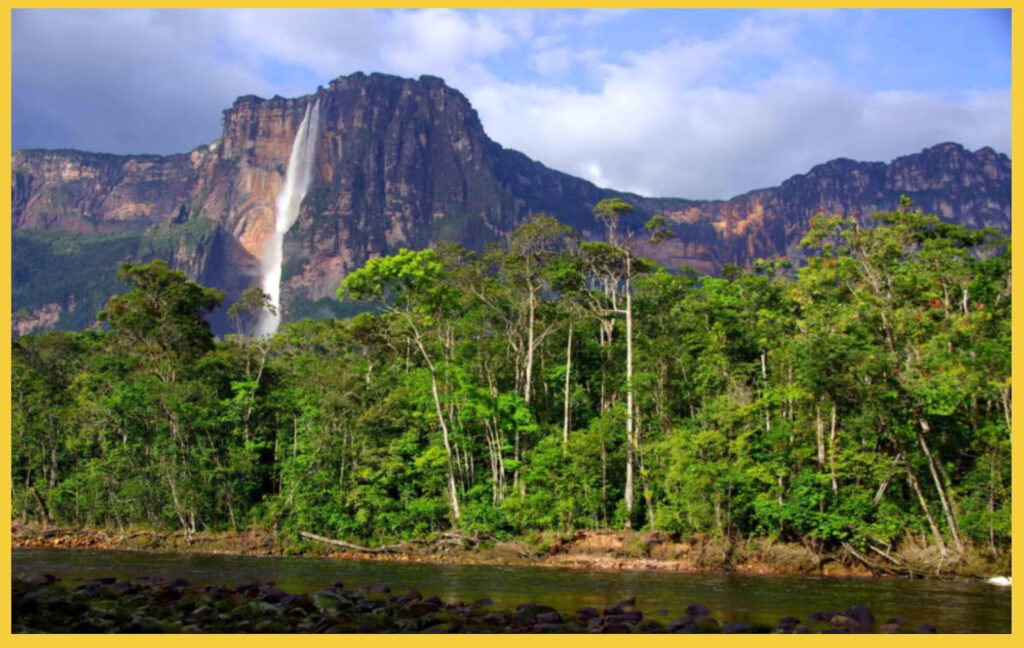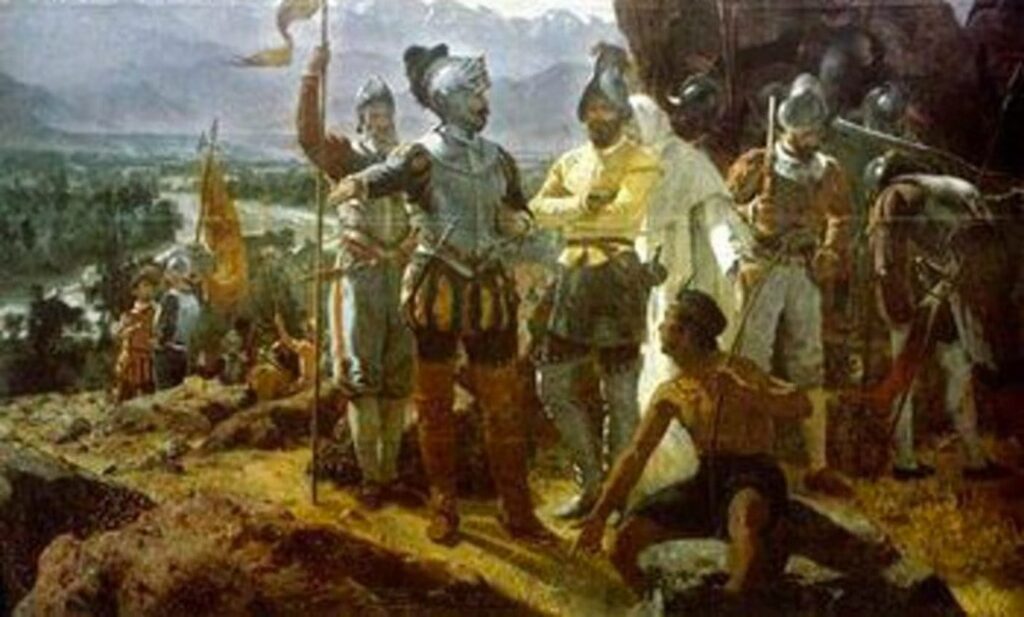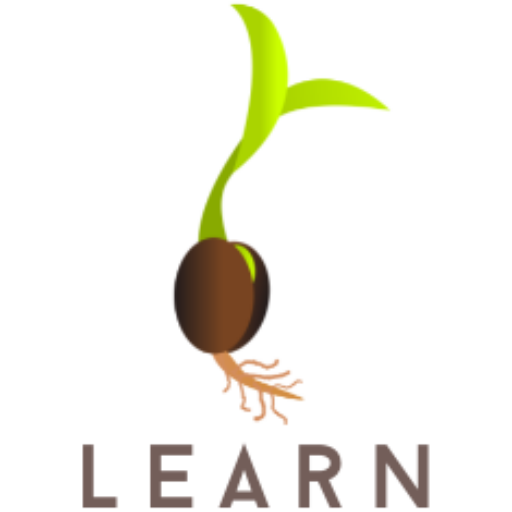Natural Environment

Credit: Antonio Jose Hitcher, 2017
Angel Falls (Spanish: Salto Ángel; Pemon language: Kerepakupai Merú meaning “waterfall of the deepest place”, or Parakupá Vená, meaning “the fall from the highest point”) is a waterfall in Venezuela. It is the world’s tallest uninterrupted waterfall, with a height of 979 metres (3,212 ft) and a plunge of 807 m (2,648 ft). The waterfall drops over the edge of the Auyán-tepui mountain in the Canaima National Park (Spanish: Parque Nacional Canaima), a UNESCO World Heritage site in the Gran Sabana region of Bolívar State. (Wikipedia)

Credit: Amaral Family, 2010
Venezuela’s habitats range from the Andes mountains in the west to the Amazon Basin rainforest in the south, via extensive Llanos plains and Caribbean coast in the center and the Orinoco River Delta in the east. They include xeric shrublands in the extreme northwest and coastal mangrove forests in the northeast. Its cloud forests and lowland rainforests are particularly rich, for example hosting over 25,000 species of orchids.
Around 38% of the estimated 30,000 species of plants found in the country are endemic to Venezuela. Around 48% of Venezuela’s land is forested; this includes over 60% of the Venezuelan Amazon. (Wikipedia)

Credit: Diario Avance, 2016
Venezuela’s diverse wildlife includes manatees, Amazon river dolphins, and endangered Orinoco crocodiles. 23% of reptilian and 50% of amphibian species that inhabit the country are endemic to Venezuela. Overall, around 8,000 species (the world’s 5th highest total) are endemic to the country.
Venezuela hosts a total of 1,417 bird species, more than 351 mammals, 341 reptiles, 315 amphibians, and more than 2,000 freshwater and marine fishes. Among the well-known invertebrate groups, there are around 900 species of marine mollusks, 1,600 butterflies, over 120 dung beetle species, and 39 species of blowflies. (Wikipedia)
Anthropological History

Description and Credit: Yanomani people
The most advanced indigenous cultures within the geographic limits of present-day Venezuela are believed to be the Timoto-cuicas, who lived mainly in the Venezuelan Andes. Peoples who lived in pre-colonial Venezuela include(d) Yekuana, Wayú, Pemón, Warao, Arutani, Caquetío, Mariche, and Piaroa. (Lifepersona.com)
The National Council of Venezuelan Indians (Spanish: Consejo Nacional Indio de Venezuela, CONIVE) is a political party established in 1989 by over 60 organizations and representatives from 34 indigenous ethnic groups including the Warao, Yucpa, Wayuu, Timotes, Panare, Yanomami and Yecuana, among others. (Wikipedia)

Description: Spanish coloniser facing indigenous people | in Credit: Susana Maria Urbano Mateos, 2018
Spanish colonisers brought diseases that wiped out the vast majority of indigenous people.
The continental colonization of Venezuela began in 1522. Indigenous chiefs tried to resist the Spanish incursions, but they were powered over by military might.
In the 16th century, Venezuela imported a considerable number of African slaves to work on cacao plantations. In the mid-eighteenth century, the Spaniards pushed deeper into the Orinoco River. During the rest of the nineteenth century, governments did little for indigenous peoples and were expelled from the country’s agricultural center to the periphery.

Colonial houses in Venezuela, credit of the picture not found
Colonial Venezuelan economy was an agrarian one, built on cocoa, coffee and the brutal oppression of indigenous people and African slaves. (Caracas Chronicles)
History, anthropology and ethnology helps us better understand relationships between the colonizers and the colonized in Venezuela. Examining various aspects of Venezuelan oral-based cultures—including religion, gender, and trade— we can more clearly see that the indigenous and black populations were never “cultural islands”—neither before nor after European penetration.
Further reading: Colonial Transformations in Venezuela: Anthropology, Archaeology, and History
Society & Culture

Credit: Venezueanalysis
Cultural evolution of Venezuela: Anthropology and archeology are overtly engaged, linking Venezuela’s history and prehistory to its present, including its current political projects. Scouring Venezuela’s history and prehistory for precedents to its contemporary socialist communes, we start to identify patterns in understanding the historical and cultural roots of the communes that Venezuelans are building today.
Several styles of the traditional music of Venezuela, such as salsa and merengue, are common to its Caribbean neighbors. Perhaps the most typical Venezuelan music is joropo, a rural form which originated in the llanos, or plains. Afro-Venezuelan music originates from descendants of the Atlantic Slave Trade and often has roots in the conditions of slavery.

Description: Arepas dish | Credit: Julia Estrada, The Spruce
Whether one roams the bustling streets of Caracas or sits down for a home-cooked meal in the countryside, they’ll savor a variety of dishes featuring classic ingredients like corn, beans, plantains, meat, and cheese.

Current Socioeconomics Crisis
Snapshot of a moment within the crisis in late February 2019 within this DW Documentary following Venezuelan investigative journalist César Batiz, who accompanied a convoy given a personal send off by Guaidó from the Colombian border city of Cúcuta. For years, César Batiz has been uncovering corruption in the oil and electricity sectors, implicating not only Venezuelan government officials, but also members of the military. Analysts say corruption is largely to blame for Venezuela’s growing crisis over the last four years. Hyperinflation, shortages of food and medicine, and frequent power outages have fuelled an exodus of more than three million people from Venezuela by official numbers – a once-wealthy country that holds the world’s largest proven oil reserves.
In this TEDxWarwickSalon talk, Andrea Arnal shares how the current social, political, and economic crisis in her country is affecting both friends and family on a personal level. People are fleeing by the millions, to leave behind a country plagued of hunger, corruption, economic insecurity, and crime. Many refer to this as a diaspora – when a country’s citizens are forced to leave their home country.
In Venezuela’s Amazonas state, malnutrition, measles outbreaks and out-of-control malaria are taking a grim toll on the indigenous population, whose woes are being compounded by unusually heavy rains and the country’s economic crisis.
Those living on an island once dubbed “paradise”, are reportedly trying to survive on just a few cents a month and many on Toas are finding it hard to feed their families, including the special needs of severely autistic children and adults. Many are undocumented citizens and, according to one, are ignored by relief authorities because they are undocumented and hence do not vote.
